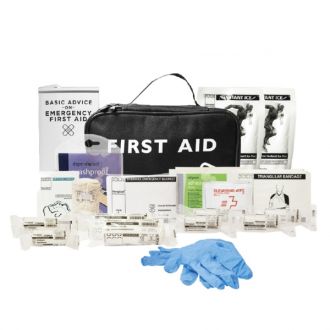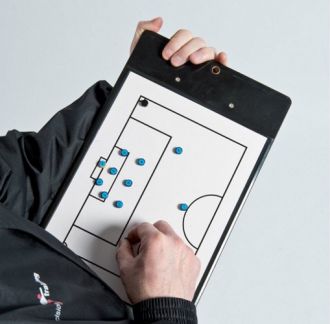7 Things Every Football Coach Should Have in Their Equipment Bag
The equipment you have at your disposal as a football coach can give you an edge over the competition. If you can make your coaching sessions and team talks more effective, you can increase your team’s chances of success on the pitch. And the right tools are the key to this success.
We’ve compiled a list of must-have items every football coach should have in their equipment bag. Gather all of them together, and you’ll be able to adapt to a wide range of scenarios — on both training pitches and match-day pitches.
1. Marker Cones
If you have a set of training marker cones in your equipment bag, you’ll be able to set up training drills and matches in seconds – wherever you are. To ensure you’re always ready for an ad-hoc session, go for a full set of colour-coded football marker cones. Lightweight and supplied with a carry stand, they’re easy to carry around and unpack.
2. A Football Coaching Folder
One of the keys to becoming a great grassroots football coach is preparation. Planning your tactics in advance and working on game plans is crucial. But you also need to communicate your plans to your players concisely and clearly. Football coaching folders help you to remember your best-laid plans and execute them when it matters.
Make notes on team tactics, team talks and individual coaching in an easy-to-carry folder designed specifically for football coaches. Make your team talks even more effective by choosing something with numbered magnets for setting out formations. Other useful features to look out for in football coaching folders include dry-wipe marker pens and two-sided displays featuring full and half pitches.
3. A Football Planner
Keeping your players organised is one thing, but managing other coaches at the same time is another. To be successful as a grassroots football coach, you need to be organised. Nothing can be left to chance. That’s why it’s important to plan both your matchday tactics and your training sessions in detail. A matchday planner lets you do just that.
A good planner includes space for notes, as well as visual reminders of important tasks. Enter team line-ups, pre-match talking points and notes for half-time. Some planners also include space for match and player reports — allowing you to track the progress of both your team and individual players.
4. A First Aid Kit
If you’re in charge of youth players, you’re probably responsible for their health and safety. Injuries are simply part and parcel of football, however. No matter how hard you try, you won’t be able to prevent sprains, cuts, gashes and the occasional broken bone. But if you’re always ready to administer first aid, you can keep pain and suffering to a minimum until professional help arrives.
Thankfully, there are some very well-equipped first aid kits on the market today. To ensure you’re ready for every eventuality, make sure your first aid kit contains the following:
- Washproof plasters
- Sterile gloves
- Sterile bandages
- Safety pins
- Cleansing wipes
- Eye pads or eye wash
- A resuscitation face shield
- Microporous tape
- Blunt scissors
- A foil blanket
For convenience, choose a first aid kit that comes with its own carry case. This will give you plenty of storage compartments for additional items such as freeze spray, cold packs, swabs and the magic spray bottles professional physios love so much.
5. Training Football
Always be prepared. If, for whatever reason, you or your fellow coaches forget the team’s footballs, you should always have access to an emergency spare. So when the worst happens, you don’t have to delay training while someone goes to fetch the bag of training footballs.
Training footballs are cheaper, versatile options available in sizes 2, 3, 4 and 5. They’re usually extremely hardwearing and 100% water-resistant. Just make sure you choose a ball that’s suitable for use on grass, astroturf and artificial pitches.
6. Spares
As well as a spare football, keep a selection of spares with you, as you never know when a player or fellow coach is going to drop the ball (pun intended) when it comes to forgetting an essential item of football equipment.
For example, every team must assign a captain, and that captain must wear an armband. Fortunately, captain’s armbands are relatively cheap, so having a few in reserve won’t break the bank. Other spare items you might want to place in your equipment bag include water bottles, finger tape for goalkeepers, sock tape and shin pads.
7. Training Bibs
Setting up training matches should be a quick and seamless process. The less time you spend on organising your players, the more time you’ll have to work with them. Quickly assign players to teams and set up training matches with colour-coded training bibs. You can either buy them separately or as part of a pack. Choose something that’s robust and easy to wash, as training bibs tend to be subjected to continual punishment. Useful features to look out for include breathable mesh materials and reinforced seams.
And whatever you do, don’t forget the coach’s bag! Something hard-wearing with lots of storage pockets, studded feet and padded carry handles will make your life as a coach a lot easier.




